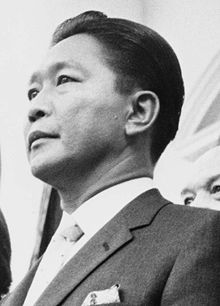 Ferdinand Edralin Marcos was the 6th president of independent Philippines who was in power from 1965 to 1986. He ruled with absolute and merciless power, taking down anyone in his way. Before he came into power, he graduated first in his class from law school, served in the armed forces, and was an assistant to Manuel Roxas. He then was elected to the House of Representatives and later the Senate, but soon, his sights were set on bigger and better things. He ran for president in the Liberal Party, but lost to Diosdada Macapagal in 1961. Angered at his loss, he joined the Nationalist Party and won in 1965. In his first two terms as president, Marcos instituted various agricultural industrial and educational reforms, but civil unrest increased. Faced with the likelihood of losing the 1973 elections, he declared Martial Law in 1972 and suspended the Constitution, ruling by decree.
Ferdinand Edralin Marcos was the 6th president of independent Philippines who was in power from 1965 to 1986. He ruled with absolute and merciless power, taking down anyone in his way. Before he came into power, he graduated first in his class from law school, served in the armed forces, and was an assistant to Manuel Roxas. He then was elected to the House of Representatives and later the Senate, but soon, his sights were set on bigger and better things. He ran for president in the Liberal Party, but lost to Diosdada Macapagal in 1961. Angered at his loss, he joined the Nationalist Party and won in 1965. In his first two terms as president, Marcos instituted various agricultural industrial and educational reforms, but civil unrest increased. Faced with the likelihood of losing the 1973 elections, he declared Martial Law in 1972 and suspended the Constitution, ruling by decree.
This marked the beginning of his downward spiral. For the next ten years he suppressed rebels, dissolved Congress, censored the press and arrested his opposition. He used the Philippines Constabulary to control and oppress any resistance. During this time, the Philippine economy was sinking under the weight of corruption and mismanagement. Soon, Marcos was in poor health, and communist and Muslim insurgencies ran amok in the countryside so he decided that the nation was ripe for change. In 1981, he ended Martial Law, but continued to rule by decree. His presidency took another turn for the worse in 1983 when Senator Aquino was murdered upon his arrival to the Philippines. This event set off massive anti-Marcos demonstrations across the country, and more unrest due to political restrictions and declining economic conditions. Corazon Aquino, the Senator's widow, was swiftly gaining popularity so Marcos, desperate to hang onto his presidency, called elections 18 months early. Aquino won the vote, but Marcos claimed his own victory. But, he has underestimated the amount of public resentment against himself. Thousands of people in nearly every province protested and rebelled against him and he was accused of election fraud. He was forced into exile after the People's Power Protest, and he went to Hawaii along with his wife Imelda where he died. His death helped him evade being tried for more than 60 counts of embezzlement and tax evasion. The Philippines in shambles with many economic problems; millions of dollars stolen and billions owed to foreign banks. The above pictures are of Ferdinand Marcos and an Anti-Marcos Demonstration in the Philippines.
